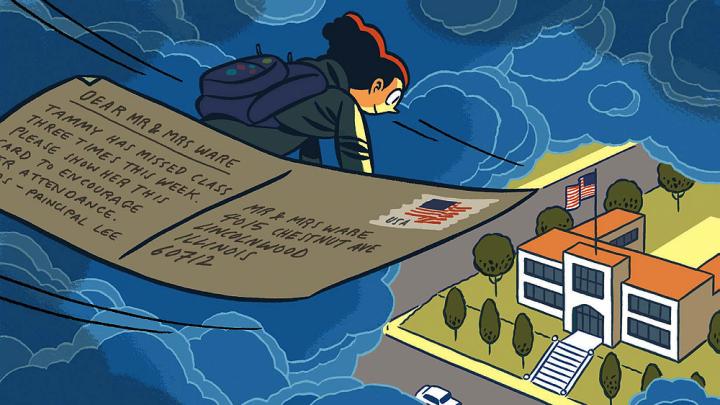Could a simple postcard, properly deployed, make a measurable impact on student absenteeism from school? The answer is yes. “Reports of the death of mail are greatly exaggerated,” quips Todd Rogers. A professor of public policy at Harvard Kennedy School, Rogers runs a lab that develops high-impact interventions to improve educational outcomes. As a former political strategist, he once applied skills at the intersection of behavioral science and social psychology, learned during his Harvard doctoral studies, to get voters to the polls (the work is described in Sasha Issenberg’s Victory Lab). But eight years ago, he dropped politics, and turned his focus instead to education. “I wanted to help kids succeed.”
He returned to Harvard to focus specifically on mobilizing family support for students. “A handful of experiments showed these crazy effect sizes,” he says, because “when you give parents useful information, they act on it.” The Student Social Support (S3) R&D lab was born to “use behavioral insights to develop scalable interventions that mobilize the social network around students” to support achievement. An ideal intervention, he says, occupies a sweet spot at the center of a Venn diagram that maps the intersection of three overlapping circles of expertise: insights into human decision-making; an understanding of key problems in education; and mechanisms for reaching scale without imposing new burdens on teachers and administrators. “It is hard to nail all three,” he explains.
Rogers is currently running an experiment that leverages preexisting relationships among 3,000 K-12 students and mentors nominated by their parents (grandparents or coaches, for example) to increase grades and test scores. The mentors receive weekly letters that might read, “Hi, these are the classes Caroline is taking, ask her what are her favorite subjects and why.” Early results in Britain testing a similar approach (but using text messages) to help students earn a high-school equivalency diploma have been very promising, he reports. Another project pushes administrative data about grades, class-skipping, and test scores—information that teachers already record—out to parents via text-messaging in order to lift grades. In an experiment with 7,000 families in Washington, D.C., when parents were automatically enrolled in the program, 96 percent of them stayed in, and the effect on student achievement was “very large,” say Rogers. Even better, “parents want more information afterward.” In other words, “Parents don’t know what they don’t know. When they get actionable information, they act on it. That improves student achievement, and then they want more.”
The project Rogers is most excited about, however, was inspired by behavioral research in energy conservation. In the utility industry, he explains, many states have empowered regulators to decouple profits from energy sales. In such markets, power companies get a fixed amount of profit per user, and then additional profit for demonstrating reductions in energy consumption. When consumers are given information about how much energy they use and how that compares with their neighbors’ consumption, they tend to cut back or become more efficient, and the effect improves over time. “People really respond,” says Rogers, “when information can correct false beliefs.”
Rogers wondered if he could adapt this approach to improve school attendance. About five years ago, he conducted a survey in Philadelphia public schools and found that the majority of parents of low-attending kids think their child’s attendance is better than that of classmates. “They also think that their kids miss half as many days as they actually do,” he reports. In a pilot study of 3,000 Philadelphia families, he and Avi Feller, then a doctoral student of statistics, mailed parents information about their child’s total absences and how that compared to classmates’, and found that it reduced absenteeism at a cost of $5 to $10 per incremental day generated—making it by far the most cost-effective intervention to reduce absenteeism. (The next best intervention appears to be the use of truancy mentors and social workers; that costs about 50 times as much.) The following year, he replicated the pattern of results with 28,000 families, and a year later with 20,000 more in Chicago, as well as in 10 districts in California. The work appears in a paper, currently in press, in Nature Human Behavior.
Schools are paying attention. The federal government’s new education law, the Every Student Succeeds Act, has led at least 36 states to select student absenteeism as one of the metrics on which their educational quality is evaluated. In turn, these states have made absenteeism one of the metrics on which school districts are evaluated. Rogers, who has done research studies with about 2,000 schools and colleges around the country, suddenly found that there was tremendous demand for help implementing such programs.
His first instinct was to help districts implement the program themselves, but “none managed to do it at scale with fidelity.” Nor was his research lab equipped to offer such services. He therefore co-founded a for-profit company, In Class Today, staffed with professionals, to help school districts around the country implement the program. The company has found that it can reduce chronic absenteeism (missing a day or more of school every two weeks) by 10 percent to 15 percent. “Obviously, this doesn’t solve the problem,” says Rogers, “but it is insanely cost-effective, easy to implement, and frees up resources” to tackle other causes of absenteeism.
Why are the postcards so effective? Continuing research revealed that the biggest push for action came not from the social comparison, but from “correcting parents’ beliefs about how many days their kid has missed.” Others have found that text messaging this information has no effect on absenteeism, Rogers reports. But the postcard becomes a social artifact, Rogers explains, something that is shared with others in the home. “We have started adding messages—‘Please show this to Johnny’—to try to encourage this virality,” he says. Parents love it, and the program even has spillover effects to siblings. In households that receive the postcards, “everyone attends school more.”








